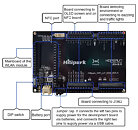- Joined
- Aug 19, 2017
- Messages
- 2,641 (0.99/day)
Huawei's HiSilicon subsidiary, which specialized in the design and development of semiconductor devices like processors, has made a big announcement today. A while back, the US government has blacklisted Huawei from using any US-made technology. This has rendered HiSilicon's efforts of building processors based on Arm architecture (ISA) practically useless, as the US sanctions applied to that as well. So, the company had to turn to alternative technologies. Today, HiSilicon has announced the new HiSilicon Hi3861 development board, based on RISC-V architecture. This represents an important step to Huawei's silicon independence, as RISC-V is a free and open-source ISA designed for all kinds of workloads.
While the HiSilicon Hi3861 development board features a low-power Hi3861 chip, it is the company's first attempt at building a RISC-V design. It features a "high-performance 32-bit microprocessor with a maximum operating frequency of 160 MHz". While this may sound very pale in comparison to the traditional HiSilicon products, this chip is used for IoT applications, which don't require much processing power. For tasks that need better processing, HiSilicon will surely develop more powerful designs. This just represents an important starting point, where Huawei's HiSilicon moves away from Arm ISA, and steps into another ISA design and development. This time, with RISC-V, the US government has no control over the ISA, as it is free to use by anyone who pleases, with added benefits of no licensing costs. It is interesting to see where this will lead HiSilicon and what products the company plans to release on the new ISA.



View at TechPowerUp Main Site
While the HiSilicon Hi3861 development board features a low-power Hi3861 chip, it is the company's first attempt at building a RISC-V design. It features a "high-performance 32-bit microprocessor with a maximum operating frequency of 160 MHz". While this may sound very pale in comparison to the traditional HiSilicon products, this chip is used for IoT applications, which don't require much processing power. For tasks that need better processing, HiSilicon will surely develop more powerful designs. This just represents an important starting point, where Huawei's HiSilicon moves away from Arm ISA, and steps into another ISA design and development. This time, with RISC-V, the US government has no control over the ISA, as it is free to use by anyone who pleases, with added benefits of no licensing costs. It is interesting to see where this will lead HiSilicon and what products the company plans to release on the new ISA.



View at TechPowerUp Main Site









